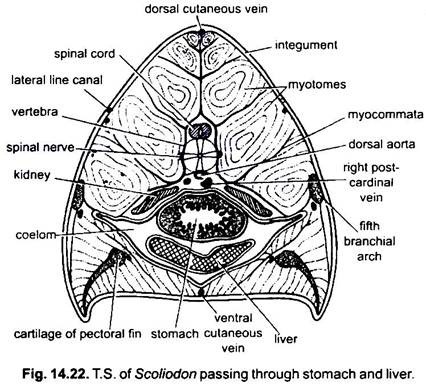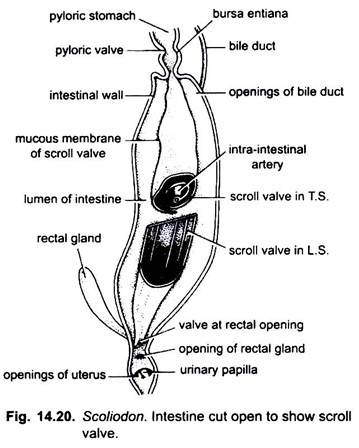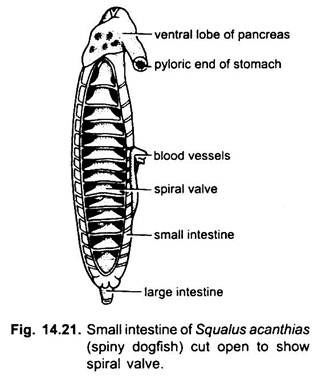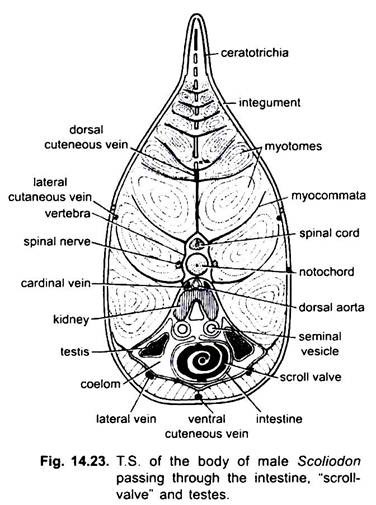In this article we will discuss about the digestive system of dogfish (scoliodon) with the help of suitable diagrams.
Alimentary Canal:
The alimentary canal of Dogfish (Scoliodon) comprises the mouth, buccal cavity, pharynx, oesophagus, stomach, intestine and rectum opening in the cloaca through anus.
a. Mouth:
It is a ventral crescentic opening guarded by upper and lower lips which are folds of integument.
ADVERTISEMENTS:
b. Buccal Cavity:
The mouth leads into a spacious dorso-ventrally compressed buccal cavity. It is bordered with jaws. The buccal cavity is lined with a thick mucous membrane. It is raised ventrally into a thick fold to form the so-called tongue which is non-muscular, non-glandular and non-protrusible. It is internally supported by basihyal cartilage. The mucous membrane is rough due to the presence of dermal denticles or teeth. The teeth are oblique and have sharp more or less compressed cusps, the edges of which are smooth and non-serrated.
They are all alike in shape, homodont, and are borne in several parallel rows on the inner margin of the upper and lower jaws. They are not attached to the jaw cartilages and are simply embedded in the skin like scales. The teeth are used to catch the prey and prevent its escape but not to crush or masticate it.
There are several rows of teeth over the jaws embedded in the mucous membrane covering the jaws. These are replaced as they become severely worn out or broken during life time (polyphyodont). There are no glands in the buccal cavity comparable to the salivary glands of higher vertebrates.
ADVERTISEMENTS:
c. Pharynx:
The buccal cavity merges posteriorly with the large pharynx lined by endoderm. The pharynx on either lateral side bears the internal openings of the spiracles and five vertical internal gill-slits of gill- pouches. The spiracle is vestigial represented by an inconspicuous oval pit having no gill lamellae and external opening and the gill-pouches are large. The cavity of pharynx is lined with mucous membrane containing numerous dermal denticles.
d. Oesophagus:
ADVERTISEMENTS:
The pharynx narrows posteriorly to form the short and wide oesophagus. The oesophagus has thick muscular walls with an internal lining of mucous membrane raised into longitudinal folds.
e. Stomach:
The oesophagus widens posteriorly to form the large muscular stomach. The stomach is bent on itself and forms a J-shaped organ, the long, wider distensible proximal limb which is called the cardiac stomach, while the short narrow distal limb is called the pyloric stomach.
At the junction of cardiac and pyloric limbs there is a blind outgrowth, the blind sac and sphincter valve. The oesophageal opening into the cardiac stomach is guarded by an oesophageal valve developed from a circular fold of mucous membrane.
Like oesophagus, the inner mucous lining of the cardiac stomach is also thrown into prominent longitudinal folds that end in the depression of the blind sac. The lining of the pyloric stomach is quite smooth proximally but is slightly folded distally. At the end of pyloric stomach there is a muscular bursa entiana. The opening of pyloric stomach into the bursa entiana is guarded by a circular band of muscle-fibres called the pyloric valve.
f. Intestine:
The bursa entiana continues into the intestine. The intestine is a wide tube running straight backwards into abdominal cavity and its middle region is like cardiac stomach in diameter. Its narrow anterior part receives the bile and pancreatic ducts.
The internal mucous living of the intestine is folded anti-clockwise into a characteristic fold the scroll valve. Its one edge attached to the inner wall of the intestine and the other rolled up longitudinally on itself into a scroll, making an anti-clockwise spiral of about two and a half turns (Fig. 14.20).
In a transverse section (Fig. 14.23) the scroll (spiral) valve looks like a watch-spring. The scroll valve serves not only to increase the extent of the absorptive surface of the intestine but also prevents the rapid flow of food through the intestine. In Scylliorhinus and Squalus, etc., the scroll valve takes about 14 to 15 turns arranged like a spiral-staircase of a tower (Fig. 14.21).
g. Rectum:
The short and narrow rectum is the last part of the alimentary canal. The tubular rectal (caecal) gland opens dorsally into the rectum. Its function is not known. The rectum opens into the cloaca through anus. Into the cloaca also open the urinogenital ducts.
Glands of the Alimentary Canal:
The glands of alimentary canal (digestive glands) are liver and pancreas.
a. Liver, Rectal Gland, and Spleen:
The liver is an elongated yellowish gland, consisting of two lobes which extend back along the greater part of the abdominal cavity. The two lobes are united anteriorly and attached to septum transversum by a ligament, but remain apart posteriorly. The right lobe of the liver carries a V-shaped thin-walled sac, the gall bladder, which stores the bile secreted by the liver.
The gall bladder communicates with the anterior end of the intestine through bile-duct. In a full grown specimen the bile duct is about 3 cm long. The liver produces bile, stores glycogen and fat. It also destroys worn-out red blood corpuscles since Kupffer cells are present.
b. Pancreas:
The pancreas is a compact bilobed gland situated in the angle between the cardiac and pyloric stomach. It comprises a longer dorsal lobe running parallel to the posterior part of the cardiac stomach and a smaller ventral lobe lying closely applied to the pyloric stomach. The pancreatic duct opens into the intestine just opposite to the opening of the bile-duct.
c. Rectal Gland:
The rectal or caecal gland is a short thick hollow diverticulum arising from the dorsal wall of the rectum. It is richly vascularised and formed of lymphoid tissue. It discharges a fluid into the intestinal lumen but the physiological effect of the fluid is unknown.
d. Spleen:
It is a large lymphoid organ attached with the cardiac and pyloric stomach. It produced lymphocytes and, thus, has no physiological relation with the alimentary canal.
Food and Physiology of Digestion:
Dogfish (Scoliodon) is carnivorous and feeds mainly on other fishes, but the diet may also include rock-crabs, lobsters and spider-crabs. Food is swallowed without mastication. The teeth of Dogfish (Scoliodon) only prevent the escape of prey from the mouth and do not perform the function of mastication. Probably the teeth may be used for tearing the food. Since there are no salivary glands in the mouth there is no digestion in the buccal cavity.
The wall of the pharynx possesses numerous mucous glands. The secretion of these glands has no digestive function but simply helps in the passage of food. The oesophagus also has no digestive function.
The digestion starts only in the cardiac stomach. The mucous membrane of cardiac stomach secretes the gastric juice which contains pepsin and hydrochloric acid that converts proteins into syntonin, proteoses and peptones. The gastric juice is not able to digest chitin.
The pyloric stomach and scroll-valve have no digestive activity of their own but they activate the pancreas. The pancreas secretes trypsin, amylopsin, and lipase. As the semi-digested food enters the intestine it is acted upon “by the bile and the pancreatic juice.
The bile makes the food alkaline and, thus, helps the action of pancreatic juice. The trypsin acts on the remaining proteins, the amylopsin converts starch into sugar and lipase turns fats into fatty acids. The digested food is absorbed into the blood over the extensive surfaces of the intestine and scroll-valve.




